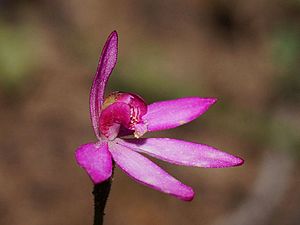Ornate pink fingers facts for kids
Quick facts for kids Ornate pink fingers |
|
|---|---|
 |
|
| Caladenia ornata growing in the Black Range State Park | |
| Conservation status | |
| Scientific classification | |
| Genus: |
Caladenia
|
| Species: |
magnifica
|
| Synonyms | |
|
|
The ornate pink fingers (scientific name: Caladenia ornata) is a beautiful type of orchid. It is found only in Victoria, Australia. This means it is endemic to that area.
This orchid has a single leaf and usually one or two bright pink flowers. The back of the flowers can look greenish-pink. Its special lower petal, called a labellum, is dark pink with dark red stripes.
Contents
What Ornate Pink Fingers Look Like
The ornate pink fingers orchid is a perennial herb. This means it lives for many years and has soft stems, not woody ones. It grows from an underground tuber, which is like a small storage root.
Each plant has one leaf, about 6 to 12 centimetres (2.4 to 4.7 inches) long. This leaf is quite narrow, only about 2 to 3 millimetres (0.079 to 0.118 inches) wide.
The orchid produces one or two bright pink flowers. Each flower is about 1.8 to 2.5 centimetres (0.71 to 0.98 inches) wide and tall. They grow on a stalk that stands about 9 to 15 centimetres (3.5 to 5.9 inches) high.
Flower Details
The back of the flowers is often greenish-pink. They are covered in tiny glandular hairs. Sometimes, the front center of the flower can be white.
The top petal, called the dorsal sepal, stands straight up. It is about 0.9 to 1.4 centimetres (0.35 to 0.55 inches) long. The two side petals, or lateral sepals, are slightly curved and spread out. They are about 1 to 1.4 centimetres (0.39 to 0.55 inches) long.
The other petals spread out widely. They are about 0.8 to 1.2 centimetres (0.31 to 0.47 inches) long.
The labellum is the most striking part. It is dark pink with dark red stripes. This part is about 0.5 to 0.6 centimetres (0.20 to 0.24 inches) long. Its sides curve upwards, and the tip points downwards. The tip also has a few small teeth.
In the middle of the labellum, there are two rows of yellow bumps called calli. These can be up to 2 millimetres (0.079 inches) long. You can see these beautiful flowers blooming from October to December.
How Ornate Pink Fingers Got Its Name
This orchid was first officially described in 1936. A botanist named William Nicholls gave it the name Caladenia carnea var. ornata. He published his description in a science magazine called The Victorian Naturalist.
Later, in 2000, another botanist, David Jones, decided it was unique enough to be its own species. So, he changed its name to Caladenia ornata. The word ornata comes from Latin. It means "decorated," "embellished," or "ornate," which perfectly describes this pretty orchid.
Where Ornate Pink Fingers Live
The ornate pink fingers orchid grows in a few separate areas in south-west Victoria. You can find it near towns like Portland, Cherrypool, Lake Fynes, and Stawell. It prefers to grow in heathy forests, which are woodlands with lots of small, shrubby plants.
Protecting Ornate Pink Fingers
The ornate pink fingers orchid is considered "vulnerable." This means it is at risk of becoming endangered if we don't protect it. It is listed as vulnerable under two important Australian laws: the Victorian Flora and Fauna Guarantee Act 1988 and the Australian Government Environment Protection and Biodiversity Conservation Act 1999.
The main things that threaten this orchid are:
- Weed invasion: Weeds can grow quickly and take over the orchid's space.
- Habitat disturbance: When the places where the orchid lives are changed or damaged.
- Trampling and grazing: Animals like kangaroos and feral rabbits can step on or eat the orchids.
Protecting these special plants helps keep our natural world healthy and diverse.


